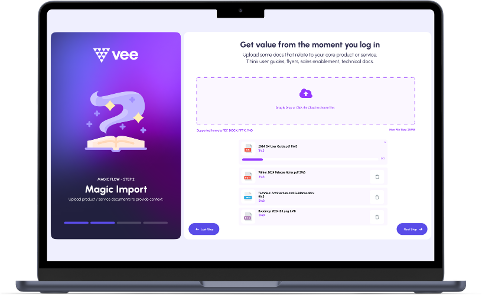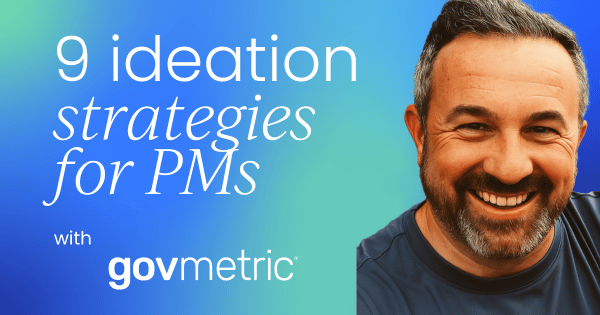When everything is built with speed in mind; something vital gets left behind.
Just as fast food strips away the soul of a home cooked meal and off-the-rack fashion will never match the intentional majesty of a Vera Wang dress, modern product development often trades true innovation for velocity.
The word innovation is used in virtually every technology company’s product copy and messaging. But only a very few companies deliver true, never-before-seen innovation – why?
In our rush to ship and learn, we risk forgetting that breakthrough products aren’t assembled in sprints; they’re crafted. As Karri Saarinen alluded to recently at Figma’s Config event, we’re entering a new cycle of product development:
One where craft, care, and deeper thinking are reclaiming their place at the heart of great product work.
Generative AI and its implementation within vibe coding tools like Lovable, Replit, and Cursor, mean its never been quicker to build, prototype, and iterate. With the mantra of move fast and break things it should be quicker than ever to get sh*t done.
But should speed alone be the North Star guiding our use of these tools? I’d assert that while AI is ‘doing the dishes’ of writing code, you can focus on honing experiences and designs that delight.

AI should create space for human creativity and originality to flourish. I’d like to think that the result of more AI is more originality. Product, and people generally, will be liberated to have the time to think up truly novel concepts and ideas because the building part will take much less time.
Indeed, I’d say it is in the interests of product managers to emphasize the value they can provide with truly novel idea inception.
Coming up with ideas is easy. It’s coming up with ideas that defy convention to deliver hitherto unobtainable results that’s hard.
AI should absolutely be exploited to make admin, alignment, and workflows trivial to complete. You’ll probably not find a bigger promoter of using AI to do so. But for real and true innovation, not copied from others or iterated from a prior model?
You need the human condition.

Nine models for ideation
As a person hardwired to commoditize and simplify everything with stories, playbooks, and frameworks, I created a grid of nine distinct models for ideation. These models (dare I say “hacks”) have helped me to create some truly novel capabilities while working in companies without huge budgets.

Like learning how to tell a story or how to present, no one teaches you how to come up with ideas. No one teaches you how to ideate using any principles, cheatsheets, or models. Given the importance of ideation, that’s fairly bonkers.
Let’s explore these ideation models that show a little of the inner workings of my mind with practical examples and some actionable steps.
1. First principles
Break problems down to their fundamental truths, then rebuild from scratch.
For most of my life, I've instinctively solved problems by thinking in first principles. I just didn't know until relatively later there was a name for it until Elon Musk popularized it.
But the approach itself is as timeless as innovation, and I’ll walk through this one in more detail, as I think it’s the one that should be foundational for all product managers and founders.

Classic example: Ford
First principles thinking involves breaking down problems into their fundamental truths, then rebuilding from there. Consider the classic Henry Ford quote:
Initial problem: Travelling from point A to point B takes too long because horses cannot move fast enough.
Typical approach: "How can I make my horse faster?”
Using first principle thinking, Ford's thought process might have looked like this:
- What exactly is needed? A faster, more reliable mode of transport.
- Does anything already exist that meets this need? Yes, trains.
- What's the limitation of trains? They only travel on tracks, limiting flexibility.
Can we create a smaller train that doesn't need tracks? Possibly. It would require rubber wheels for traction, similar to bicycles, and an engine for propulsion, like other machines of the time.
By questioning assumptions, Ford didn't just improve existing methods; he invented something entirely new – the motor car.
First principles thinking doesn't just enhance existing solutions; it unlocks entirely new possibilities.

More recent application: Government accounts
In 2013, I was tasked with designing a new digital government account for citizens. Existing solutions simply exposed siloed back-office systems (think: separate portals for welfare, housing, and social care), resulting in poor UX and high friction.
Initial problem: Interacting with public services was frustrating due to fragmentation, complex authentication, and clunky design. Government’s aim was to shift citizens from costly calls to cheaper digital channels.
Typical approach: Build a centralized app that merges data from multiple back-office systems.
Instead, applying first principles and the Five Whys, I asked:
- What is the primary goal? Reduce service delivery costs
- Secondary goal? Lower call volumes by driving digital adoption
Aggregation and UX mattered, but they weren’t the root issue. We reframed the problem:
- Why do people call? Over 1,000 services reduced to ~100 common questions or actions
- Which areas have the most calls? Waste, tax, welfare, housing
- Which calls must stay human-led? Services for vulnerable or high-risk individuals
From this insight, we built:
a) Real-time citizen authentication to any back office
b) A unified API connecting 30+ disparate systems
c) Personalized FAQs that answered the most common questions but importantly with data held about that citizen
With a single login, citizens could resolve the 100 key action types online. Within just one month, call volumes dropped by 50%, and annual savings of £500,000 were the result.
Though built for government, this principle applies broadly, as most organizations suffer from fragmented data across systems that drag down productivity.
We didn’t do what others did. We used first principles to solve for the root problem in a novel manner.
Process to apply first principle thinking:
- Clearly define your problem.
- List underlying assumptions.
- Challenge each assumption rigorously.
- Rebuild your solution using foundational truths.

2. Counter-intuitive thinking
Challenge assumptions directly to reveal hidden opportunities.
Counter-intuitive thinking questions the very assumptions your industry accepts as absolute truths and embraces solutions that seem illogical at first glance but ultimately deliver exceptional value. This model is powerful because it exposes hidden value in overlooked places.

Classic example: Airbnb
Airbnb countered traditional hospitality logic by enabling strangers to share homes, which was a previously unthinkable idea. Initially, the idea of renting out a room in your home to strangers seemed bizarre and I’d argue unsafe.
But by challenging the conventional wisdom around hospitality, Airbnb didn’t just carve out a new market; they reshaped an entire industry and generated $11 billion in revenue in 2024.
Example from my own life: Onboarding
Onboarding customers quickly and easily, particularly in product-led growth companies, makes a massive difference to conversion. A user is put on a prescriptive path, and people click buttons to indicate their role/use case, the name of their team, and then an app to invite others.
But in all honesty, once you’ve logged in, the experience is vanilla. With this structured approach to onboarding, the process might be rapid, but nothing has really been properly optimized based on your company, product, or services.
So, what’s the opposite of a structured flow? An unstructured one.
By thinking of what that might look like, I came upon a hybrid approach that delivers a novel outcome. Hybrid in that the flow has standard steps, but importantly, the way you provide context about your organization is unstructured.
The beauty of agentic AI is that one can use tools like LLMs/GPTs/APIs to take unstructured data and create a highly structured and valuable set of data by merging multiple signals into a cohesive whole.

The above flow resulted in the following being automatically generated:
- ICP profile,
- Personas,
- Value proposition,
- Positioning,
- Product messaging,
- Competitive landscape and battle cards,
- Sales enablement content, objections, and rebuttals, and
- Suggested GTM motions.

This means, within minutes of accessing the application, everything has been personalized, and there’s already value being afforded to the customer.
As such, I’m almost certain that this pattern will become a norm in onboarding.
How to apply counter-intuitive thinking:
- Identify dominant industry assumptions.
- Imagine doing precisely the opposite.
- Test this unconventional approach in controlled environments.
- Refine and scale successful outcomes.

3. Lateral thinking
Borrow and adapt ideas from unrelated fields.
Edward de Bono invented one of the most widely known ways of thinking about problem solving. Lateral thinking allows one to find inventive solutions by deliberately choosing to take a sideways step from conventional thought paths.
You will almost certainly know it by another name: Thinking outside the box.

Classic example: Dyson
Consider Dyson’s vacuum cleaners a Great British inventor. While competitors like Hoover had focused purely on suction power, James Dyson asked a fundamentally different question: Could the problem of diminishing suction be solved entirely differently?
By applying cyclonic separation technology; borrowed from industrial sawmills, he created vacuums that had unprecedented efficiency and reliability because they bypassed traditional design limitations.
Real-life example: Influencer marketing
When one is taking a product to market, especially as a founder, a realllllly tricky aspect is GTM. How do you tell the world about your product without spending huge amounts on events, ads, and influencer marketing?
An approach, which I’ve not really seen in any other GTM/productivity apps, is the concept of promoting other peoples services inside your app in the context of what your app does. Miro has the Miroverse, but that’s just showing what others have done.
Your users are hopefully your ICP. But they’ll also be the ICP of people providing knowledge services that have huge followings on LinkedIn/Substack.
My lateral thinking was that you could create a quid pro quo by enabling GTM experts (or whatever subject matter your product is) to promote their services, paid newsletters, etc., within your app.
This way, the service provider has a massive new channel (if the product is widely adopted) and the software supplier has a free marketing/promotion channel.

This Magic Maker idea turns influencers into evangelists through reciprocal benefit, laterally transforming traditional influencer marketing into a cost-free, mutually beneficial model.
Adopting lateral thinking:
- Articulate your core problem.
- Investigate analogous issues in unrelated fields.
- Borrow external solutions creatively.
- Adapt and validate these borrowed solutions in your context.

4. Narrative design
Use storytelling to emotionally connect and engage users.
Stories shape how we see the world, making narrative design powerful for deep user engagement. Narrative design uses storytelling to guide product development and enhance user experience.

Classic Example: Duolingo
Duolingo exemplifies this beautifully. Unlike traditional language-learning software, which often felt academic and dry, Duolingo wove language-learning into playful, narrative-driven lessons.
They turned learning into a journey, compelling users to return regularly and achieve their language goals.
Narrative design makes your product memorable by connecting deeply with users' emotions and aspirations.
Recent idea from my own experience: Gamma
Gamma’s automated pitch decks leverage narrative design, automatically creating structured, persuasive stories that resonate deeply with stakeholders.

Wouldn’t it be super if they had an API so that your product could plug into Gamma with the context/knowledge held in your product to automate sales enablement/product release briefs, etc.?
Implementing Narrative Design:
- Map your user’s emotional journey.
- Embed compelling narrative arcs into your product.
- Continuously refine your stories based on user feedback.
- Strengthen emotional connection and recall.
5. Intuition-led
Trust gut instinct over pure analytics to guide product decisions.
Intuition-driven innovation trusts gut instincts over rigid data to find resonant product-market fit. Intuition-led thinking enables rapid pivots toward impactful simplicity and user delight.

Classic example: Instagram
The creation of Instagram illustrates this clearly.
Initially built as a check-in app called Burbn, its creators realized their gut was pulling them toward simplicity and visual storytelling; something they felt instinctively would resonate with users.
Trusting intuition over analytics, they stripped features away, leaving only photo-sharing, which left Instagram as the iconic platform it is today.
Harnessing intuition:
- Observe deeply and reflect on gut responses.
- Quickly prototype intuitive ideas.
- Rapidly validate through user interactions.
- Iterate decisively, trusting instinct alongside data.

6. Inversion
Reverse your perspective to approach problems from the opposite direction.
Inversion flips a problem upside down, often revealing entirely new opportunities. It involves reversing your perspective by solving problems backward or upside down.

Classic Example: Netflix
Netflix asked, "What if customers didn’t visit video rental stores at all?" radically reshaping video consumption.
Rather than trying to improve the video rental store experience, they inverted the question. By flipping the perspective and bringing DVDs to customers directly, Netflix initiated a chain of innovations culminating in the streaming revolution we now take for granted.
Example from my own experience:
Sales velocity wasn’t optimal because sales were reliant on highly technical people to join calls, handle objections, and technical people to ‘close’ the deals.
The problem was the people doing those calls had day jobs building the products, and there weren’t enough of them. Plus, it meant the sales process was highly asynchronous if calls couldn’t be run with everyone on them.
The question we asked was, “What if there were no technical resources to call on?”.
By pondering this, we realised the solution would mean sales calls would need to be synchronous, sales would inherently need to have access to more knowledge, and sales velocity would be optimal.
The solution was to leverage Recall’s real-time transcript capability and link it to a knowledge base/RAG LLM solution that was able to:
- Provide real-time sales engineer/technical answers as they were asked
- Be updated every time a product update happened or competitor intel was garnered
Essentially sales reps are more effective, sales enablement is automatic, and velocity wins because sales can work without email ping pong or managing calendar chess.
Practicing inversion:
- Define your problem explicitly.
- Reverse assumptions to create novel perspectives.
- Prototype solutions based on inverted insights.
- Validate and refine radically new concepts.

7. Constraint creativity
Deliberately impose limitations to inspire innovation.
Limitations drive powerful innovation when embraced creatively. Constraint creativity harnesses restrictions to unlock new thinking.
Twitter’s 140-character limit, originally imposed by SMS technology, forced users to distil thoughts into concise, impactful messages.
Far from stifling creativity, the constraint amplified it, shaping a distinct format that became Twitter’s hallmark.
Constraints do not always block innovation; they sharpen the need for it. They force prioritization, clarity, and, oftentimes, elegance.

Classic Example: Twitter
Twitter’s original 140-character limit forced concise, impactful communication.
Lateral but related example: DeepSeek
Recently, and unlike the Twitter scenario, DeepSeek were forced to apply constraint creativity because they didn’t have access to the computing and training resources of the west.
So, rather than simply scaling models with brute force, they focused on reinforcement learning to iteratively refine performance using smaller, smarter loops.
This constraint demanded efficiency and more thought put into the process, but the outcome was a highly capable language model with better cost-performance tradeoffs. Their constraint became a catalyst and had a spectacular effect on the market. Not a compromise.
How to apply constraint creativity:
- Set deliberate boundaries.
- Innovate specifically within these constraints.
- Prototype rapidly and evaluate results.
- Sustain creative limitations to foster ongoing innovation.

8. Emotional intelligence
Deeply empathize with users to forge lasting emotional connections.
Empathy and deep emotional understanding powerfully differentiate products. Products built with emotional intelligence deeply understand and resonate with users' emotional states.
Emotional intelligence turns products into cherished companions, creating enduring bonds with users.

Classic example: Calm
Calm, the meditation app, is a prime example.
By thoughtfully addressing users' emotional needs for relaxation, comfort, and mental clarity rather than simply selling meditation as a productivity tool, Calm has become synonymous with emotional well-being.
Ultimately, earning dedicated loyalty.
How to integrate emotional intelligence in:
- Identify core emotional needs of users.
- Design features explicitly addressing emotional states.
- Constantly refine based on emotional user feedback.
- Forge lasting emotional connections with users.

9. Serendipitous discovery
Remain open to unexpected findings to uncover hidden breakthroughs.
Innovation often springs from accidents. Provided you’re open enough to notice and act. Serendipitous discovery recognizes opportunities arising unexpectedly through experimentation or fortunate accidents.
This principle teaches us the value of openness, experimentation, and flexibility, turning unexpected findings into game-changing innovations.

Classic Example: Slack
Slack emerged this way in that it was originally developed as an internal communication tool within a gaming startup.
Realising its value came by accident, the founders embraced the serendipity, pivoted entirely, and Slack quickly became a ubiquitous team collaboration platform.
Encouraging Serendipity:
- Foster experimentation.
- Regularly review accidental outcomes.
- Quickly prototype serendipitous findings.
- Validate and scale valuable discoveries.
Wrap up
In an AI-accelerated world, this structured originality will be the enduring differentiator between merely functional products and truly breakthrough innovations.
In other words, the next game-changing idea is unlikely to come from incremental adjustments but, rather, from your uniquely human perspective.
Are you giving yourself the space to have it?
Much of today’s product and even content about product feels iterative. But I’m hopeful that the carefully crafted principles and practical examples set out above give you a fresh insight into a world of rinse and repeat content.
So that you can use your ultimate USP and superpower – your humanity – to be a better product manager.




 Follow us on LinkedIn
Follow us on LinkedIn












